User:Jrcrin001/Carpenter sisters
The topic of this article may not meet Wikipedia's general notability guideline. |
This article is written like a personal reflection, personal essay, or argumentative essay that states a Wikipedia editor's personal feelings or presents an original argument about a topic. |
This article contains wording that promotes the subject in a subjective manner without imparting real information. |
The Carpenter sisters of Leiden, Netherlands and Plymouth Colony provided a unique genetic impact and moral influence to the colonization of the Plymouth Colony in America in the early 1620s. Juliana (1584 England – 1665 Plymouth), Agnes (1585 England – 1615/1616 Netherlands), Alice (1590 England – 1670 Plymouth), Mary (1595 – 1687 Plymouth, never married), and Priscilla (1597 Netherlands – 1689 Plymouth) became their family matriarchs that settled the hearths, maintained Pilgrim Fathers family life under difficult religious times and many gave birth to the next generation under harsh physical conditions in the difficult early years.
Their pioneer immigration to the Americas would be felt in the Plymouth Colony descendants of the George Morton family, the Edward Southworth family, the Plymouth governor George ‘William’ Bradford family of Plymouth Plantation, and the William Wright family. While the impact of the men are more widely known, the Carpenter sisters full impact may never be fully understood or known to history. These Carpenter sisters served quietly, faithfully and with dedication to their religion, families and each other.
Family[edit]
The Carpenter sisters were daughters of Alexander Carpenter (1546/1551 England – 1612 England) and Priscilla Dillen (abt 1552 England – 1653 England). Their father Alexander Carpenter is often cited as a merchant of Wrington, Somersetshire, England and he married his wife Priscilla about 1581 in Somersetshire. Alexander’s ancestry has not been confirmed. His parents are believed to be William Carpenter and Joanne or Abigail Bluther of Wrington and his lineage may descend from the Carpenters of Homme and Dilwyn in Herefordshire.[1][2]
At the Saint James parish of Bath[2] in northeast Somerset, England we find two children of Alexander Carpenter baptized. This article uses the commonly known spellings of names where the old records often have variant spellings.
- Nathaniel Carpenter July 15, 1582. It is believed that he died by 1610 in Leyden, Zuid Holland, Netherlands. No marriage has been found.
- Julian (Juliana) Carpenter March 7, 1584. She would later marry George Morton on July 23, 1612 at Austerfield, Yorkshire, England and bear him six children.[3] Later she would marry Manasseh Kempton about 1627 in Plymouth. She died on February 19, 1665 in Plymouth.[4] Her husband would later be listed as “G. Mourt” who would write an introduction to “A Relation or Journal” later known as “Mourt's Relation.”[5]
Wrington Church records (1550–1612) reveal the following baptisms;[2]
- Joan Carpenter August 2, 1590. She died February 13, 1610 in Wrington. No marriage found.
- Alice Carpenter was baptized on August 30, 1590 in Wrington, but her record was not found.[5] She may have been a twin of Joan. Alice later was courted by many, including a young William Bradford. She returned his affections, but her parents opposed the marriage. She would later marry Edward Southworth on May 28, 1613[6] in Leyden who died by 1622 probably in London. They had at least two children. Alice would immigrate to the Plymouth Colony where she would marry Governor William Bradford on August 14, 1623 and would bear him six children. She would die a widow in Plymouth on April 5, 1670/1671.[5][7]
- Ann Carpenter October 1, 1592. She died before October 1600 in Wrington.
- Agnes (Anne(s)) Carpenter December 16, 1593. She would marry Samuel Fuller as his second wife on April 24, 1613 in Leyden and she would die there, probably in childbirth, on July 3, 1615/1616. She was buried at St. Peter’s Church. No known surviving children.[8]
- Mary Carpenter February 6 1596/1597. After her father died in 1612, she took care of her mother until her death in 1653 at Wrington. At the bequest of her sister Alice, Mary came to Plymouth about 1654 and would die there on March 19, 1687, unmarried.
- Priscilla Carpenter September 3, 1598. She would marry William Wright and bear him at least three children. After his death at Plymouth in 1633, Priscilla would marry the new immigrant John Cooper on November 27, 1634. She would die on December 29, 1689 in Duxbury, Plymouth County in the future state of Massachusetts.[9]
The gap between the two historical records above allows the possibility of other children.[3]
Two other children are often attached to this family, most probably in error. The first is Bridget Carpenter on Wrington who some claim married a Samuel Fuller then a Thomas Vincent. She is often confused with “Bridget White Lee” who as a widow married Samuel Fuller, as his third wife, in Leiden on May 27, 1617[10] and sailed on the Mayflower with her husband. This Bridget was the younger sister (not the daughter born 1608) of Catherine White who married John Robinson. The third "Mrs Fuller" (Bridget White Lee Fuller) arrived on the “Ann” in July of 1623. No other Bridget's are listed. That ship contained Julian Carpenter Morton and her husband George Morton along with Alice Carpenter Southworth did not have Alice's two sons. They came later.[11]
The second oft cited child is William Carpenter born between 1576 and 1586, later of Salisbury in Wiltshire who married Mary Batt, a daughter of Reverend Robert Batt and Alicia Lockey on April 18, 1605 at St. Thomas in Salisbury. This ‘person’ is confused with another William Carpenter who married a Mary Batt and was from another Carpenter line.[12]
To better understand these Carpenter sisters, the following sections are provided as a brief background of the historic events they were involved with.
England to Netherlands[edit]
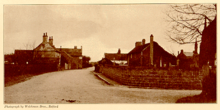
Separatist leadership came from religious congregations who had begun to flee England in 1608. There was a volatile political environment lead by Tobias Matthew[13] in the East Midlands of England toward the relative calm & tolerance of Holland in the Netherlands. The Separatist beliefs had long been controversial. Under the Act of Uniformity 1559, it became illegal not to attend official Church of England services. Fines and imprisonment were often given to violators that included the Carpenter family. In the Columbia Encyclopedia, it is stated that "Although not actively persecuted, the Scrooby Congregation was subjected to ecclesiastical investigation and to the mockery, criticism, and disfavor of their neighbors."[14] It was illegal to leave England without permission and the Separatists hired Dutch ships to sneak them out. On many occasions the English authorities seized the families before they could board. Many were released, except for their leaders. Later their leaders were fined and released. In small groups they eventually made it to the safety of the Netherlands by August 1608.[5]
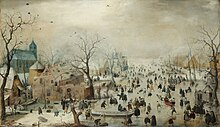
The Carpenters first went to Amsterdam and found the menagerie of religious sects there a distraction. The Scrooby group the Carpenters belonged to had problems with another Separatist group from Gainsborough in England.[5] That group had fled just before them and wished to leadership over the newer groups arriving. They may have been aligned with the "The Ancient Brethren" a group who arrived a few years before them. Dutch authorities were written a letter on February 12, 1609 asking permission for the Scroobys to move to Leiden. This was granted in May and they quickly moved to the smaller city.[5] The Carpenters are mentioned several times in the Leiden Church records after 1610 participating in marriages, wills and property records.[15][16]
1620 to 1623[edit]

The success of the congregation in Leiden was mixed. Leiden was a thriving industrial center.[17] Some Separatist members found living in a foreign land difficult with new and strange jobs often monotonous. Many would leave and go back to England to the land they disliked, but understood better.[5] But those who stayed struggled and paid off their debts quickly. Those immigrants who did not have Dutch language skills, a teaching ability or craft were marginalized in the Netherlands. This included the remaining Carpenter sisters. After twelve years in the Netherlands, the same problems or distractions they met in Amsterdam were present. In addition, their religious tenets were one of many in the city. Their ability to influence their young and convert others to their viewpoints became diminished every year. They began to realize that their children were growing up more Dutch than English and some were losing the faith of their parents.[5] Another factor was simple economics. As the children grew older and families increased in size, the need to meet their debts increased. This resulted in older children and some women working outside the home. Many children became worn from the daily work and old before their time. The Scrooby group discussed and voted on going to an isolated land to practice their religion. The city government found their behavior impeccable during their stay and they were allowed to plan and to immigrate to the new world called America.[5]
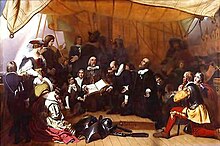
Julian Carpenter Morton and Alice Carpenter Southworth and their families apparently in late 1619 or early 1620 had residence at the Heneage House (the former home of Thomas Heneage), on Duke’s Place (a street), in Aldgate, an area of London known to be home to hundreds of Dutchmen as well as a large number of religious dissenters. That is where Edward Southworth died by 1622.[18]
William Bradford, who would later marry Alice Carpenter, with his first wife, and Doctor Samuel Fuller, the widower of Agnes Carpenter his second wife, then married to his third wife Bridget White Lee Fuller (who would come over in 1623 on the "Ann", sailed on the Mayflower from Southhampton in Hampshire with the Speedwell on August 5 (Old Style)/August 15 (New Style). The Speedwell had to turn back and the Mayflower eventually arrived in the new World on September 6/September 16, 1620.[19][5]
In 1621, 35 new colonists arrived on the ship “Fortune.” Julian Carpenter and her husband George Morton came to Plymouth on the ship "Ann" in July 1623 with her sister Alice Carpenter Southworth who soon married Gov. Bradford. The “Ann” and “Little James” brought 60 new colonists. Now almost 200 people were present in Plymouth.[11][20]
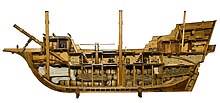
By 1629, new immigrants were constantly being added and expanding the colony. The Plymouth Separatists called them “Strangers.” Religious intolerance in England led to the development of the Massachusetts Bay Colony.[20] The “Great Migration” had started and the need for better harbors and land bypassed Plymouth. In time the Separatists would create other congregations outside of Plymouth.[3]
Plymouth Colony was limited with their small boat harbor and limited land. Separatists numbers began to diminish with each generation as the young moved to seek a better life. By 1644, more Separatists were outside Plymouth than inside.[5] While Plymouth never became a ghost town, it became secondary community which in 1691 was incorporated into the Massachusetts Bay Colony. In time non-separatists out numbered the Separatists, but a group of Separatists still exists today in Plymouth, Massachusetts. Bradford's 1654 lament "A Word to Plymouth" would surely be different today. Plymouth's population was 51,701 at the 2000 census, with an estimated 2009 population of 58,681.[21]

—
- “O poor Plymouth, how doth thou moan,
- They children are all from thee gone,
- And left thou art in widow’s state,
- Poor, helpless, sad and desolate.”
- “A word to Plymouth” by Governor Bradford in 1654.[22] —
Women Separatists[edit]
In the early 1600s life was difficult for the Carpenter sisters and the rest of the women. They maintained their households with cleaning, food preparation, child birth, child raising, the making of clothes, and making other basic items needed for the family. They supported each other in good times and bad times. They cleaned and prepared their dead for burial. Life would go on and their sisterhood was always a close bond.[23]
While in England many of the first generation women had a basic understanding of their letters and numbers. Many could read the scriptures. In later generations the Separatists congregations stressed education for the males but not for females. Many women would teach numbers and basic math to their daughters. The need to prepare food, make clothing and to ration often scant supplies required this. The best known Carpenter sister, Alice Carpenter Southworth Bradford, was claimed to be functionally illiterate by today's standards, but she could still read her scriptures! After the merging with the Massachusetts Bay Colony all children in larger towns were required to attend school which resulted in a literacy rate higher than England and most of Europe for that time.[5]
During the religious meetings the women were divided from the men, yet equal under God.[24] All would stand, men with men and women with women, for hours during the meetings. After a break and refreshments provided by the women they would gather in groups to discuss what was said. These groups included active participation by the women. While many could not read the scriptures, all did memorize biblical passages that were read to them.[5]
One of the myths of the early pilgrims was that they all dressed in black somber clothing. While the clothing was plain in style, the colors of red, blue and brown were commonly used in the making their clothing. One of the reasons for the myth is the pilgrim term for their colors were, “sadd colurs.”[25] One old definition of “sadd” meant unfashionable and unadorned.[26] It is always important to use the context of the time for word definitions and terms. Today the word “sad” often means feeling sorrow, regret or unhappiness due to some event like death. Black is a traditional mourning color in the United States. Then black cloth was expensive and the dye faded quickly, so it was used only for special or fancy occasions. Combine the "sad colors"[25] with a simple unadorned and unfashionable outfit and you get the idea why people once thought they always wore black somber clothing.[23]
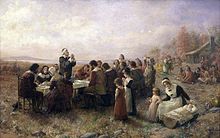
The English Carpenter sisters and other women knew how to prepare food they were familiar with from Europe. In America they had new plants, animals and herbs. They learned to use and find these new items from the Native American women. History often overlooks the bond between women in establishing relations. The “First Thanksgiving” meal was a combination of English and native food prepared by the women. The basics included wheat, Indian corn, beans, leeks, onions, peas, fowl and fish. The Indians contributed five deer. And it may have been made into a “sobabeg” a Wampanoag stew.[27] There was no pecan pie, ice cream, ham or sweet potatoes and no turkey.[28][29]
Separatist women and men were not considered equal from either a legal or social standpoint. Plymouth women enjoyed extensive property and legal rights over their European counter-parts. Widows in Plymouth could not be legally "written out" of her husband's will and were guaranteed a full third of the family's property upon his death. Women were parties to contracts in Plymouth; most notably prenuptial agreements. It was common for brides-to-be (and not, notably, their fathers) to enter into contractual agreements on the consolidation of property upon marriage. In some cases, especially in second marriages, women were given exclusive right to retain control of their property separately from their husbands. Women were also known to occasionally sit on juries in Plymouth, a remarkable circumstance in seventeenth century legal practice. Historians James and Patricia Scott Deetz cite a 1678 inquest into the death of Anne Batson's child, where the jury was composed of five women and seven men.[24]
The death rate for the first 102 colonists and residents in Plymouth was about 50% that first year. As William Bradford wrote, "of these one hundred persons who came over in this first ship together, the greatest half died in the general mortality, and most of them in two or three months' time".[30] Of the 16 females, 12 died that first winter for a mortality rate of 75%.[24] Between 1621 and 1627 only 6 colonists died, half were women.[5] Mortality rates were high for both mother and child; one birth in thirty resulted in the death of the mother, resulting in one in five women dying in childbirth. Infant mortality rates were high, with 12% of children dying before their first birthday.[24] Alice Carpenter Southworth Bradford’s death eulogy was probably typical of all the Carpenter sisters.
—
- "On the 26th day of March, 1670, Mistris Allice Bradford, Seni'r,
- changed this life for the better,
- haueing attained to fourscore years of age, or therabouts.
- Shee was a godly matron, and much loued while shee liued,
- and lamented, tho aged, when shee died,
- and was honorabley enterred on the 29th day of the month aforsaid,
- att New Plymouth."
- Plymouth Colony Records, Vol. 8, p. 33[31] —
See also[edit]
- First Parish Church in Plymouth
- List of Mayflower passengers who died in the winter of 1620–21
- List of Mayflower passengers
- National Monument to the Forefathers
- Plymouth Rock
- The Mayflower Society
- Thanksgiving (United States)
References[edit]
- ^ Holman, Mary Lovering. Scott Genealogy. Boston, MA: Family History Library (FHL) US/Can book 929.273 Sc84h. FHL film 1033607.
- ^ a b c "Scott Genealogy". The Mayflower Quarterly. 39. Boston, MA: The Mayflower Society, The General Society of Mayflower Descendants: 182–183. Retrieved 2009-09-26. Cite error: The named reference "SRO" was defined multiple times with different content (see the help page).
- ^ a b c Anderson, Robert Charles (1995). The Great Migration Begins: Immigration to New England 1620–1633. Vol. Volume 2. Boston, MA: GreatMigration.org. pp. 1296–1298. Retrieved 2009-09-26.
detail George MORTON.
{{cite book}}:|volume=has extra text (help) - ^ Savage, James (1860). A Genealogical Dictionary of the First Settlers of New England, showing three generations of those who came before May, 1692, on the basis of Farmer’s Register. Boston, MA: online version by Stephen M. Lawson. p. 244. Retrieved 2009-09-27.
- ^ a b c d e f g h i j k l m n Bradford, William; Edward Winslow, (1865) [1622]. Henry Martyn Dexter (ed.). Mourt's Relation, or Journal of the Plantation at Plymouth. Boston, MA: John Kimball Wiggin. OCLC 8978744. Retrieved 2009-09-25.
{{cite book}}: CS1 maint: extra punctuation (link) - ^ Lewis, Frederick (1988) [1979]. Ancestral Roots of Sixty Colonists – Who came to New England between 1623 and 1650. Boston: John Kimball Wiggin / Genealogical Publishing Company. pp. 12–41. ISBN 0806312076. ISBN 0-8063-1207-6. Retrieved 2009-09-27.
- ^ Anderson Volume 1, Bradford pages 207–209 and Carpenter Sisters on pages 313–314.
- ^ Carpenter, Daniel Hoogland (1901). History and Genealogy of the Carpenter Family of America, From the Settlement at Providence, R. I. 1637. Jamaica, NY: The Marion Press. Retrieved 2009-09-27.
- ^ Anderson 1:313–14, 3:2075–76.
- ^ "Mayflower Descendant Legacy". Mayflower Descendant. Vol. 8 (no. 3). Boston, MA: Massachusetts Society of Mayflower Descendants: 129–130. 1906. Retrieved 2009-09-27.
{{cite journal}}:|issue=has extra text (help);|volume=has extra text (help) - ^ a b Willison, George F. (1945). Saints and Strangers. New York: Reynal & Hitchcock. p. 437 The Pilgrim Company. ISBN 014008973X. Retrieved 2009-09-23. See also: Plymouth Colony Records, Vol. 12, p. 5–6.
- ^ Carpenter, John R. "Carpenters' Encyclopedia of Carpenters 2009 (DVD format)". Retrieved 2009-09-26.
- ^ Luckock, Herbert Mortimer (1882). Studies in the History of the Book of Common Prayer. London: Rivingtons. p. 219. OCLC 1071106. Retrieved 2009-09-25.
- ^ The Columbia Encyclopedia. "Pilgrims". Retrieved 2009-09-26.
- ^ Griffis, William. "The Pilgrim Press in Leyden". New England Magazine. 19/25 (January 1899). Boston: Warren F. Kellogg: 559–575. Retrieved 2009-09-26.
- ^ Tammel, Johanna W. The Pilgrims and other people from the British Isles in Leiden. Isle of Man, England: Mansk-Svenska Publishing Co., Ltd. pp. 66, 95, 195, 211, 248. ISBN 090771529X.
{{cite book}}: Cite has empty unknown parameter:|1=(help) - ^ Harreld, Donald. "The Dutch Economy in the Golden Age (16th – 17th Centuries)". Economic History Services. Retrieved 2009-09-25.
- ^ Sibley, Mrs. Mary J. "Family of Edward Southworth". Retrieved 2009-09-28.
- ^ Deetz, Patricia Scott; James F. Deetz. "Passengers on the Mayflower: Ages & Occupations, Origins & Connections". The Plymouth Colony Archive Project. Retrieved 2009-09-24.
- ^ a b Morton, Nathaniel (1855). New England's Memorial. Boston, MA: Congregational Board of Publication. Retrieved 2009-09-27. Contains a reprint of “Thomas Prince's New England Chronology.”
- ^ "Town of Plymouth Population Projections" (PDF). Town of Plymouth. Retrieved 2009-07-17.
- ^ Usher, Roland G. (1918). The Pilgrims and their History ((1984 reprint) ed.). New York: The MacMillan Company & reprinted by Corner House Publishers in 1984. p. 182. ISBN 0879280824. Retrieved 2009-09-26. Contains a reprint of “Thomas Prince's New England Chronology.” Also printed in Mass. Hist. Soc. Proc, 1st Series, XI, 479
- ^ a b Hawke, David (1966). The Colonial Experience. Indianapolis, IN: The Bobbs-Merrill Company. ISBN 0023518308.
- ^ a b c d Demos, John (1970). A Little Commonwealth: Family Life in Plymouth Colony. New York: Oxford University Press.
- ^ a b "Sad Color Schemes". ColorSchemer Gallery. Retrieved 2009-09-30.
- ^ Oxford Concise Dictionary (2001) [1999]. Sad. Oxford University Press.
unfashionable ... ORIGIN OE sæd 'sated ...
{{cite book}}:|access-date=requires|url=(help) - ^ Plimoth, Plantation (2009). "Wampanoag Homesite". Plimoth.org. Retrieved 2009-09-27.
- ^ Heath, Dwight B. (1963). Mourt’s Relation: A Journal of the Pilgrims at Plymouth. Bedford, MA: Applewood Books. Retrieved 2009-09-27.G. Mourt wrote the introduction and is better known as George Morton, husband of Julian Carpenter.
- ^ Vaughn, Alden T. (1973). New England Frontier: Puritans and Indians, 1620-1675. Boston, MA: Little, Brown and Company & reprinted by University of Oklahoma Press in 1995. ISBN 080612718X. ISBN 978-0806127187. Retrieved 2009-09-27.
- ^ Patricia Scott Deetz; James F. Deetz (2000). "Mayflower Passenger Deaths, 1620–1621". The Plymouth Colony Archive Project. Retrieved 2009-09-30.
- ^ Carpenter, Edmund Jane (1918). The Mayflower Pilgrims. New York: The Abingdon Press & reprinted by the Christian Liberty Press in 1993. ISBN 1930092172. Retrieved 2009-09-27. Plymouth Colony Records, Vol. 8, p. 33.
Further reading[edit]
- Anderson, Robert Charles (1995). The Great Migration: Immigrants to New England 1620-1633. Boston, MA: GreatMigration.org. Retrieved 2009-09-26. 3 volumes
External links[edit]
- Pilgrim Archives, Searchable municipal and court records from Leiden Regional Archive
- Photographs of New York (Lincs-UK) and Pilgrim Fathers monument (Lincs-UK)
- Church of the Pilgrimage, founded after an 1801 schism
- Pilgrim Hall MuseumPilgrim history and artifacts
- Mayflower Steps All about the Mayflower and Pilgrim Fathers with a Plymouth (UK) focus including pictures
- Pilgrim ships from 1602 to 1638 Pilgrim ships searchable by ship name, sailing date and passengers.
- General Society of Mayflower Descendants and The Mayflower Society.
- Mourt's Relation as transcribed by Caleb Johnson
- Mourt's Relation as transcribed by Caleb Johnson
- Admiral MacBride Pub Built upon the original Mayflower Steps from where the pilgrim fathers set sail for America.
